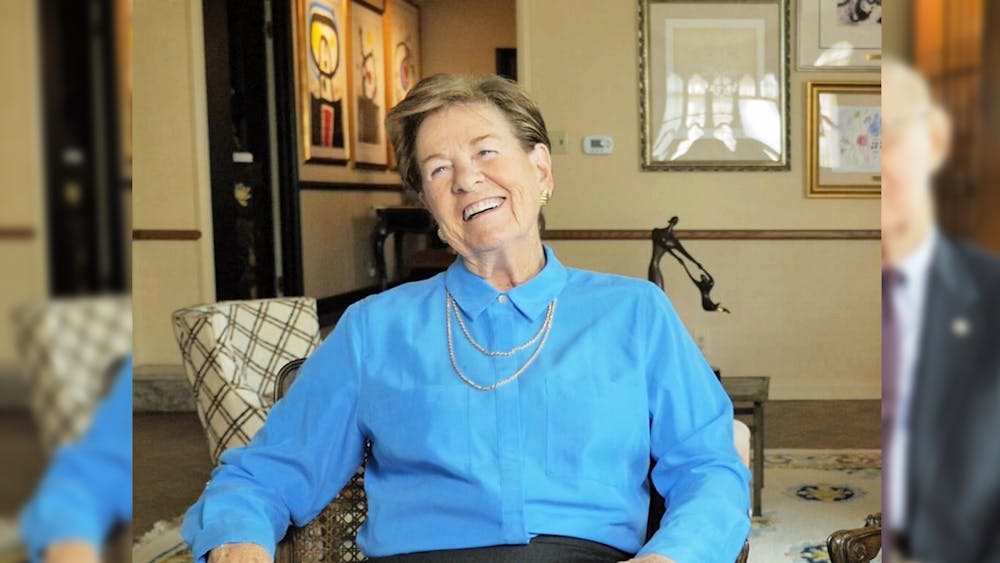The Mathers Museum is presenting an exhibit on materials that united people of most cultures, but rarely noticed. \n"Everyone wears shoes," said Ellen Sieber, curator of collections at the Mathers Museum of World Cultures.\nSince April, the museum, located at 416 N. Indiana Ave., has been home to an exhibit featuring highlighted artifacts from across the globe in a student-designed show called "Talking Shoes." The exhibit, a requirement for Introduction to Museum Studies students, was conceived and produced in six weeks by mostly undergraduate students with an interest in museum relations.\nThe class was divided up into two sections, one given the task of doing a children's exhibit, "Talking Shoes," and the other an adult-concentrated exhibit, "Preserving Liberia: The IU Connection." After the division, students designated to do the children's exhibit chose from a collection of 30 to 40 pairs of shoes selected by the museum's curators of education and exhibit, which they then narrowed down to the final 20 pairs. \nSieber said the project was quite a challenge.\n"Students had to take everyday objects and find many ways to talk about them and invite children to connect the exhibit with their lives," she said. "They had to open their eyes to practical aspects of putting on an exhibit in a different perspective for kids."\nThroughout the 6-week process, students read children's books in order to observe literature that was easily processed by children, so when it came time to write the captions for each pair of shoes, they would be better equipped to write for their pre-determined audience (children from 3- to 5-years-old). Other preparations for the exhibit included in-class discussions, developing themes and working in the conservation lab learning to prepare and preserve articles for the exhibit.\nJudith Kirk, class instructor and assistant director of the Mathers Museum, discussed how such a show is beneficial to students.\n"It's all about getting hands-on experience, that's what we're here to do -- we are a resource. Students are actually accomplishing something, rather than turning in papers," she said.\nKirk believes other IU students not involved in the class can \nbenefit from visiting the exhibit. \n"Students that are interested in early childhood development can get a lot out of this institution," she said. "It can help them to see how they can explore more options." \nAs the project progressed, the IU students designers came up with collaborative ways to mentally engage children observing and being educated about the shoes. These ideas included adding a mirror low to the ground to allow one's own feet to be observed when first entering the exhibit and encourage thinking about what others around the world wear on theirs. \nA board was designed with the label "touchy-feely shoes" and consists of small doors, which could be slid to reveal various fabrics used to make shoes worldwide. Also displayed is a world map, which has flags posted marking each country represented by shoes in the exhibit, including Republic of the Congo, Tibet and the Netherlands. \nOne pair of shoes featured in the show was Peruvian tire shoes from the 1960s, the caption in child-friendly font reading: "People make shoes out of just about anything! Some people from Peru recycled old tires to make these shoes. These kinds of shoes were worn by guides on the Inca Trail who walked many miles." \nNot far off was a pair of Inupiat Eskimo snowshoes worn by people in the arctic United States. The caption explained the shoes' practical use of keeping people from sinking in the snow by distributing their weight. \nDecorative shoes were also on display, such as Pakistani wedding shoes from the 1960s, which were decorative heels worn by brides on their wedding day. Japanese shoes from the 1970s were also on display to illustrate shoes made for the purpose of sound. Made of wood, these shoes were decorated with painted bird patterns and had bells underneath which created a jingling sound when worn. \nAlthough "Talking Shoes" was completed in just six weeks, that does not mean others are as rapid in their development; most small exhibits take a year to plan. The Mathers Museum's next large exhibit, opening Nov. 5, titled "Thoughts, Things, and Theories … What is Culture?" has been 10 years in the making. Special sets are being constructed for this exhibit, in addition to new display cases being added as a result of grant money received for the project. \n"Talking Shoes" will be on display through Nov. 6, and is free to the public, as are all other Mathers exhibits. For more information on the exhibit and the Mathers Museum, visit their Web site at http://www.iub.edu/~mathers.
Shoe show treads new ground for IU students
Mathers shoe exhibit specially by, for students
Get stories like this in your inbox
Subscribe





